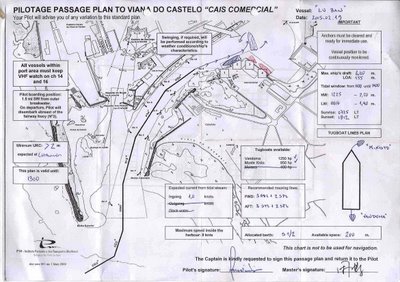According to several international recommendations and taking into account the experience obtained throughout the years, the Viana do Castelo Pilotage Department created and implemented a pilotage passage plan for each manoeuvre on the port.
This passage plan is filled beforehand by the duty pilot and, among other things, is used as a pre-embarkation check-list for the pilot that will also be handed to the ship’s captain to be signed.
The captain will then be aware of the prevailing circumstances, complementing his own knowledge of the conditions of the port.
This plan aims to improve the safety parameters for the port traffic but do not replaces the usual verbal exchange of information between pilot and master.
The responsibility of presenting a berth to berth passage plan rests upon the ship’s captain, although this is seldom done. In fact, most of the voyage plans are only “pilot to pilot”, that is, the most dangerous part of the voyage, the port passage, is not conveniently prepared.
The pilotage passage plan has inherent advantages. The fact that you are giving anticipated knowledge to the vessel’s crew of relevant details for the navigation and berthing allows a clear understanding of the risks involved, safety margins and suitability of the intended manoeuvre according to the ship’s characteristics.
The pilot’s intention will be clear, including the use of tugs (number and bollard pull), under keel clearance, available berths, tidal window, mooring procedures, as well as any necessary change due to external factors (wind, current, visibility, traffic, port regulations, etc.).
This information, combined with the pilot card, will permit an early discussion of the proposed passage and the establishment of alternative contingency plans.
The present tendency of the shipping industry to operate vessels manned with sub-standard crews has increased the number of misunderstandings in communications between the intervenients in the safe navigation of the ship. This pilotage passage plan aims to decrease those misunderstandings and encourage bridge team work, thus decreasing the chances for error.
This plan has been received very well by the vessels coming to Viana do Castelo, with many captains asking to make a copy to complement their own passage plans and for future reference. When required, we can also make the necessary modifications to the plan due to the existence of a digital format.
This passage plan is filled beforehand by the duty pilot and, among other things, is used as a pre-embarkation check-list for the pilot that will also be handed to the ship’s captain to be signed.
The captain will then be aware of the prevailing circumstances, complementing his own knowledge of the conditions of the port.
This plan aims to improve the safety parameters for the port traffic but do not replaces the usual verbal exchange of information between pilot and master.
The responsibility of presenting a berth to berth passage plan rests upon the ship’s captain, although this is seldom done. In fact, most of the voyage plans are only “pilot to pilot”, that is, the most dangerous part of the voyage, the port passage, is not conveniently prepared.
The pilotage passage plan has inherent advantages. The fact that you are giving anticipated knowledge to the vessel’s crew of relevant details for the navigation and berthing allows a clear understanding of the risks involved, safety margins and suitability of the intended manoeuvre according to the ship’s characteristics.
The pilot’s intention will be clear, including the use of tugs (number and bollard pull), under keel clearance, available berths, tidal window, mooring procedures, as well as any necessary change due to external factors (wind, current, visibility, traffic, port regulations, etc.).
This information, combined with the pilot card, will permit an early discussion of the proposed passage and the establishment of alternative contingency plans.
The present tendency of the shipping industry to operate vessels manned with sub-standard crews has increased the number of misunderstandings in communications between the intervenients in the safe navigation of the ship. This pilotage passage plan aims to decrease those misunderstandings and encourage bridge team work, thus decreasing the chances for error.
This plan has been received very well by the vessels coming to Viana do Castelo, with many captains asking to make a copy to complement their own passage plans and for future reference. When required, we can also make the necessary modifications to the plan due to the existence of a digital format.
Example of a filled pilotage passage plan
